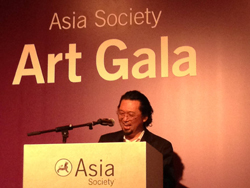News
- 2017/06/09Talkshow: MADSAKI Solo Exhibition, “Here Today, Gone Tomorrow”
- 2016/10/17A Special Exhibition Commemorating the Release of the Catalog for Takashi Murakami’s Superflat Collection
- 2014/12/25Live Talk Report: Aso Kojima x Takashi Murakami
- 2014/09/27Live Talk Report: Kazumi Nakamura x Mika Yoshitake
- 2014/05/27About speech at the Asia Society
- 2013/06/20Exhibition “Takashi in Superflat Wonderland” Opening From July 4
- 2013/06/01Anri Sara, Matthew Monahan participated in the Venice Biennale
- 2013/05/17Kenjiro Okazaki – “Et in Arcadia Ego, The Hidden Place Called “Sculpture”
- 2013/04/16ob x Kazuki Sugawara: Live Performance in conjunction
- 2012/11/30Aya Takano, “Heaven Is Inside Of You”
- 2012/11/30Macy’s Thanksgiving Day Parade
- 2012/10/17Regarding The Temporary Break Period for Kaikai Kiki Gallery Taipei and Hidari Zingaro Taipei
- 2011/10/31Artist Talk by Anri Sala at L’Institut Franco-Japonais de Tokyo
- 2011/10/19Anri Sala x Takashi Murakami Live Talk at Louis Vuitton Japan/ONE Omotesando
- 2011/10/13No Window No Cry (Junzo Sakakura, L’Institut, Institut franco-japonais de Tokyo) on display at L’Institut Franco-Japonais de Tokyo et Yokohama
- 2011/10/06Anri Sala – Concurrent Exhibition at the National Museum Of Art, Osaka
- 2011/06/21google Anniversary logo
About speech at the Asia Society
The New York art world news website recently poked a little fun at my speech at the Asia Society Gala Dinner in Hong Kong but just so everyone can have some context, I would like to post the full English text here:

<The Transcript of the Speech>
As you know, I am a Japanese artist, though I really first started building my career in the United States.
As a country in Asia, Japan has always had a stance of receiving and accepting the influences of foreign cultures. In the past, we have absorbed culture from Korea and China, and after we lost the Second World War, we have done the same from the victors, such as the United States, the United Kingdom, and France.
Similarly, I feel that the post-war Asian contemporary art scene has frantically tried to quickly absorb the forms from the West. The theme of integration and contrast between the East and the West was set. The effort started with the imitation of the West, and then shifted abruptly to the expressions of Asian originality, which haven’t been entirely successful, but the attempt at merging the East and the West still goes on as we speak. In fact, the experiment only seems to be speeding up.
Art fairs now actively bring Asia and the West together. I believe this Asia Society’s gala is an occasion to celebrate this fact. And when I think about the meaning of my being honored at such an occasion, I suspect that there is an expectation for a future breakthrough.
Where, then, shall we set the point of such a breakthrough?
How about I suggest that it should be fixed on the idea of artistic innocence.
Art is, at the most fundamental level, an instrument used to formulate the understanding of and limitations of the human being. I believe that it is a medium that functions especially well in formulating the understanding of human desire. And as the apparatuses of desire, art fairs and auctions are extremely effective.
To contemplate desire, let us think about Damien Hirst’s auction at the Sotherby’s in September 2008. The direct involvement of the artist in the auction received extraordinary criticism. It was reproached as profiteering, selfish, and destructive of the harmony of the industry.
As it squarely coincided with the major economic crash, it led to a confusion in the market. Although the result might have been great on the day of the auction, the actual sales didn’t go so well, and is talked about in a negative light. People say it was a failure both in terms of business and for his brand as an artist. I, however, take the completely opposite view. In the long run, art historically, I believe that his courage will receive much higher praise and its meaning will be reevaluated.
I understand that, regardless of East or West, it is desirable for an artist to remain innocent about the market. However, I don’t think a breakthrough is possible if we clung to such a naively pleasant ideal.
When I say this, you may think that I am a market supremacist, but this is not the case. I simply believe that my duty is to stand up to those who criticize and put a lid on the unsavory or unsightly, and to vividly depict realistic scenery. Because, in fact, art already has the appearance of a zombie.
What is a zombie? It’s what you see in the sci-fi films, where, for whatever reason, a human dies, and despite that fact, he continues to move about and devour flesh. The art scene today, I think, is a world full of such zombies. And it is brain-rippingly stunning in that these zombies are falling in love and are building families.
The internal landscape of the people today might be desolate and utterly destroyed. What, then, is art that is needed in this landscape?
I intend to keep working with such questions in mind.
And I sincerely appreciate your continuing guidance and support.
Thank you.
(Speech on May 12, 2014)
http://galleristny.com/2014/05/takashi-murakami-on-the-art-world-full-of-zombies/